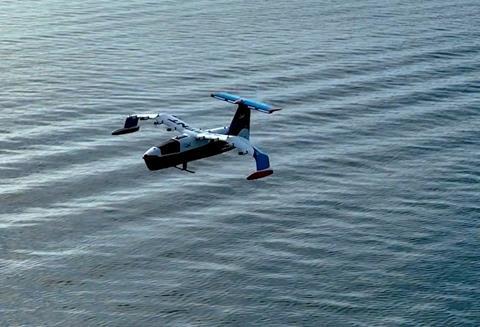Start-up seaglider developer Regent Craft’s sub-scale prototype achieved an important milestone last month on its journey to become a viable transport option along coasts or near large bodies of water.
The company’s demonstrator, a one-quarter-scale model of a production aircraft it plans to call “Viceroy”, successfully transitioned from floating to travelling as a hydrofoil ferry, to flying, during tests in Naragansett Bay, off the coast of Rhode Island, chief executive Billy Thalheimer tells FlightGlobal on 22 September.

“This is a really big step for seagliders,” he says. “The point of seagliders is to make this regional transportation accessible and easy. And in order to do that, you need to have wave tolerance and comfortable rides, to be able to operate at high frequencies, be weather agnostic, so you can be utilized, so your cost goes down and so people can rely on your service.”
“Historically, the problem was, no one has been able to push a foil fast enough [through the water] and get a wing slow enough where they overlap. That is the key innovation of Regent and the key distinguishing factor of the seaglider from all wing-in-ground-effect vehicles in the past.”
The all-electric wing-in-ground-effect (wig) vehicle is designed to fly within one wingspan over water to take advantage of aerodynamic and operational efficiencies. The craft’s “sweet spot”, however, is about one-quarter to one-half wingspan, Thalheimer says, enabling increased payload capability and greater range than other electric aircraft concepts currently in development.
Ground-effect is lift generated while an aircraft flies close to the surface of the earth, forcing air through the narrow space between the aircraft and the ground, and reducing aerodynamic drag.
The sub-scale prototype has a wingspan of 18ft, and Viceroy’s wingspan will be about 60-65ft. So the craft will probably travel at an altitude of around 10-30ft over the water.
BOAT, HYDROFOIL, AIRCRAFT
“We’re going to board like a boat, we’re going to foil through the harbour as a hydrofoil ferry, and we’re only going to fly out in the open ocean when we can use the speed and when no one’s in the way.” he adds. “So the key part of all of this is how do we couple this foil, which gives us the wave tolerance and safety and manoeuvrability with the wing.”
“Functionally, we are the first wave-tolerant wig, on a technical basis were the first hydro-foiling wig. And so we couple this actively controlled hydrofoil with our electric distributed propulsion blown wing technology,” he says.
The company hopes to have the entry-level Viceroy, which will carry up to 12 passengers and two crew members, begin sea trials in 2024 and is aiming to have craft in revenue service in 2025. Initially, it will travel at a top speed of 162kt (300km/h), for up to 162nm (300km), though Regent says improving battery technology could eventually enable its vehicles to have more than 400nm of range.
The company is working with the US Coast Guard to certify the craft as a maritime vehicle but is also coordinating with the FAA, it has said.
In May, Regent announced it was working on a second, larger craft called “Monarch”. That vehicle will carry up to 100 people and is planned to enter service by 2028, Thalheimer says.
At that time time, Hawaiian Airlines also made a strategic investment in Regent, viewing the Monarch as having the potential to operate inter-island routes.
Hawaiian is Regent’s first US-based design partner for Monarch, and the seaglider could serve as a replacement for Hawaiian’s ageing 17-strong Boeing 717 fleet, which complete most of the carrier’s island-hopping routes. Those aircraft are, on average, more than two decades old, according to Cirium fleets data, and Hawaiian has said it is beginning to look for alternatives to replace them in the coming decade.
Thalheimer adds that both airlines and ferry operators, in several regions of the world, are interested in the craft. About half of the company’s $7 billion in pre-orders are from airlines, and the other half from maritime operations.

”Regent has created the solution for people who want to travel on these regional routes that are painful on a plane and painful in a boat,” he says. A seaglider is six times faster than a traditional ferry, and the craft can serve a new market for an airline. Operating costs are also lower, and all-eletric seagliders eliminate emissions.
“Both of those kinds of companies are servicing the end-customer that’s just trying to get across a body of water,” he adds. “The other exciting thing is that we’re starting to see the formation of the world’s first dedicated companies that operate sea gliders exclusively.”
Regent is initially targeting routes, for example, between Hawaiian islands, Miami to the Bahamas, New York City to Long Island, or Boston to the islands of Nantucket and Martha’s Vineyard, he says. In Europe, “we can do all around the Mediterranean, Italy, Greece, or across the English Channel”.
As batteries improve, he’s looking at serving longer routes by the end of the decade, “using either advanced cells or hydrogen technology to power our later vehicles”. That would enable a Regent seaglider to travel non-stop between Boston and New York City, or Los Angeles to San Francisco.
In February, Regent said it had raised $18 million in funding, led by Thiel Capital, with participation from existing and new investors, including US regional carrier Mesa Air Group. As part of the deal, Mesa has committed to purchase 200 seagliders.






















